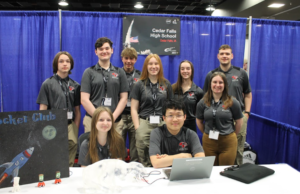Rocket club’s rocket ready for NASA

Over the past six months, the rocket club has collaborated with NASA to build a rocket that will be flown at NASA base in Huntsville, Ala. Now, an over six-foot rocket sits in the engineering room, awaiting the long drive down to Alabama for its final flight. The team has already test flown the rocket twice, both flights exceeding the team’s expectations.
“Our maximum that we can go is 5,600 feet, so a little over a mile. We went about 6,300 feet. We were about a thousand over what we expected to go,” adviser Zeb Nicholson said.
Similar to the rocket, the team itself has exceeded Nicholson’s expectations.
“There is no way I would be able to do this with any group of kids. Some teachers say that sentimentally. This team is a one of a kind team. They have always been that way since last year working on TARC [Team America Rocketry Challenge]. That is how they got 5th place at Nationals,” Nicholson noted. “Not because they got lucky or they had one guru that did everything. It is because that team of six kids has worked together, figured stuff out and got it done. That doesn’t happen with every team. I know for a fact next year we are losing two seniors from this team of six, and that is going to be a huge blow.”
The team started working together last year for the Team America Rocketry Challenge, and after receiving the proposal continued the teamwork and commitment to the program by accepting NASA’s proposal, passing the proposal and successfully launching the rocket.
“The goal for me is to just hit the milestones and complete the project. These guys have had to give half hour presentations every other month since October to NASA engineers. If they do not like what they see they will not be afraid to tell you.” Nicholson said.
With many hours of work and presentations under the team’s belt, the motivation for this year is much different than previous years.
“The main goal is to have fun and for the experience,” sophomore Randev Goonesekere said.
Nicholson notes how this year the team’s external motivation has dissipated from last year, and the team is left with pure want of success.
“Their intrinsic motivation has contributed to their success. There is no money involved in this project. The only money involved is money going out. TARC each kid got about $800, but this year there is no money or awards. It has just been work and your reward is the satisfaction of getting to do a cool project and seeing these rocket launch,” Nicholson said. “There is no first, second or third place. What it will be is we are going to send these solar panels up, collect our data, run our experiment and come back to Iowa and write a report about what we found”
Through the process, the team has not been alone either.
“The coding and the computer side has been the biggest challenge,” senior Ryan Ritter said.
With little coding knowledge, the team received help from a past CFHS graduate from the class of 1980 who has worked at NASA for over 25 years.
The team also received a grant from UNI along with help from a senior in the engineering program.
“The reason that we have overcome those challenges is the UNI students helping us out. We have had wonderful mentors,” Nicholson said.
Wednesday, April 4, the team will fly the rocket in Huntsville, and following the flight, the team will have to type a data report to send to NASA to conclude the collaboration.
Through many months of hard work, Nicholson said the team has stayed true to its one main goal.
“It all comes down to having a good time and being able to say that you have worked with NASA.”









You must be logged in to post a comment Login